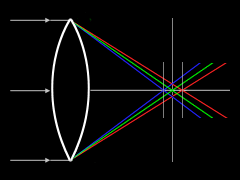Improvements on The Design
Galileo’s
telescoped were far ahead of the curve but
they were surpassed eventually. There were several ideas
on how to make
telescoped better. In 1611 Johannes Kepler replaced the
eyepiece in his
telescope to a convex lens from a concave lens. This
allowed for a much larger
field of view which was a big problem with Galilean
telescopes. The drawback of
the convex lens eyepiece was that it inverted images. This
could be fixed by a
third convex lens however the third lens reduced the
quality of the images.
Other
astronomers such as Rene Descartes attempted
to make the telescope more like the human eye by using
hyperboloidial or
elliptic lenses. In 1637 Descartes demonstrated a
telescope with hyperboloidial
lenses which actually got rid of spherical aberration.
Spherical aberration is
a problem in telescopes where the light coming from the
edges and the center of
a lens do not converge to the same focal point, this gives
the appearance of
smeared light. However Descartes telescope had a new
problem called chromatic aberration.
Chromatic aberration is the result of different colors
failing to focus at the same
convergence point. This effect also produces smeared
images with added halos
around them. The image below is a model of chromatic
aberration.

Another
line of thought for improving telescopes was
to make them longer. Longer telescopes produced finer
images because the
refracted light rays were able to fit within a smaller
focal point. Johannus
Hevelius constructed a telescope that was 140 feet long.
The problem with such
large telescopes was the difficulty in keeping them
perfectly straight.
